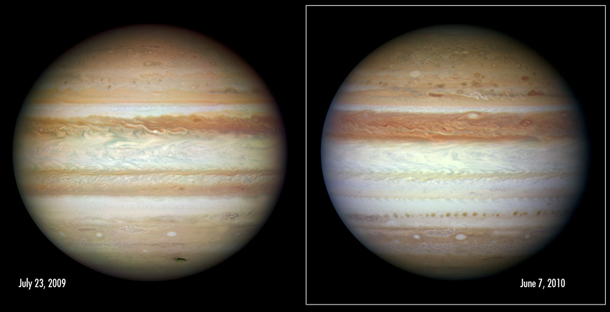A month ago, something big burned up in Jupiter’s atmosphere. The impact was seen by two amateur astronomers, and very quickly the big guns were turned to the giant planet.
And what they saw was… nothing. Nada. Bupkis. Not even the powerful eye of Hubble saw anything. See for yourself:
This picture of Jupiter was taken on June 7, just a few days after the impact. The image on the right is a closeup, and the circle represents where the impact took place, and there’s nothing there we can see. In previous impacts – most notably the one last year in July, and the Shoemaker-Levy 9 series of impacts in 1994 – nasty black bruises appeared on the planet’s cloud tops. Those were impact scars, plumes of material blasted up from deeper in Jupiter’s cloud, dredged up by the multi-megaton explosions. You can see this by comparing an image of Jupiter taken last year after the July impact with what they got this year:

The 2009 impact scar can be seen in the left hand image near the bottom of Jupiter. There is no such scar seen for the newer impact. That means that whatever hit Jupiter didn’t explode deep in the atmosphere. The observations imply strongly that whatever hit burned up high in the atmosphere, more like a giant fireball than an impact and explosion. Given how bright it was, I’m personally of the opinion that this may not have been a giant solid asteroid, like a piece of rock or metal. If it was that fragile, it may have been what’s called a rubble pile; a loose conglomeration of rocks held together by their own gravity.
At the moment, because we didn’t see anything it’s hard to say anything positive. We can eliminate a few possibilities, but it’s hard to know exactly what happens. These observations definitely help, but are also in their way a little maddening. What the heck happened on Jupiter?
As an added bonus, these observations also show (OK, don’t show) the missing southern equatorial belt; a planet-wide storm wrapped around Jupiter. In the older shot you can see it, but a few months ago it disappeared, and is missing in the newer shot. This has happened before, but it’s unclear why. In the new images you can see that the storms north and south of the missing belt look different now too, perhaps a clue as to what’s going on. There is a series of brownish circular storms all lined up, more or less, and other odd features as well.
All in all, I think we can sum all this up by saying Jupiter is a weird place. Mind you, it’s 140,000 kilometers across (86,000 miles), which is a heckuva lot of real estate to try to understand. I expect the questions and answers will change, but I bet that in a hundred years, astronomers studying Jupiter will still have plenty of mysteries on their hands.
Credit: NASA, ESA, M.H. Wong (University of California, Berkeley), H.B. Hammel (Space Science Institute, Boulder, Colo.), A.A. Simon-Miller (Goddard Space Flight Center), and the Jupiter Impact Science Team